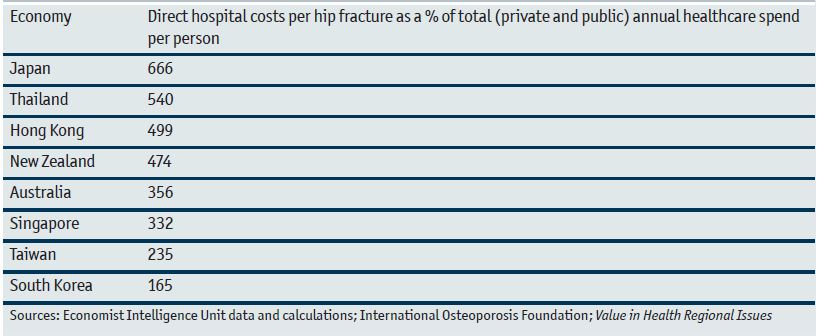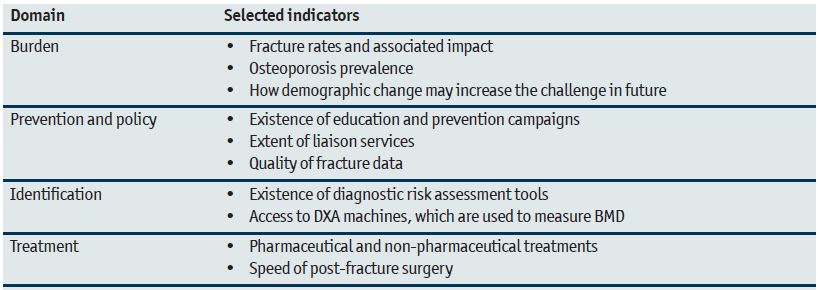- Current healthcare policies and practices are insufficient to address potential rise in “fragility fractures”, which are caused by osteoporosis, according to a new assessment of eight Asia-Pacific economies
- Implementation of coordinated care in the form of fracture liaison services (FLSs) needs accelerating across the region
- South Korea has strong data on fractures but weak FLS roll-out, while the opposite is true of Singapore; Hong Kong’s hip fracture rates are improving, but gaps in treatment remain
- Policymakers and advocates must improve poor patient awareness of fracture risk and osteoporosis in order to make progress
Healthcare systems across Asia-Pacific will be unable to avert a predicted fragility fracture epidemic among the elderly unless they take steps to address its cause, osteoporosis a disease which makes bones brittle and more likely to break, according to a new study released today by The Economist Intelligence Unit (EIU).
The white paper Demystifying ageing: lifting the burden of fragility fractures and osteoporosis in Asia-Pacific, sponsored by Amgen, is based on expert interviews and the findings of a scorecard assessing fracture and osteoporosis burden and response in Australia, Hong Kong, Japan, New Zealand, Singapore, South Korea, Taiwan and Thailand. It finds that while some steps are being taken across the eight economies to address the challenge of fragility fractures, in which bones can break relatively easily, progress is slow and much more needs to be done.
Ageing societies will naturally see more people with weaker bones: by 2035 populations of all the study economies except Australia and New Zealand will be about 50% over 50, the age at which osteoporosis commonly begins to manifest. Though some places, such as Taiwan and Hong Kong, are currently seeing age-standardised fracture rates decline, more elderly people likely mean more fractures in absolute terms—the economic costs of which can be immense (see table).

Yet a range of interventions means an epidemic of human suffering due to fractures is not inevitable. FLSs, in which fracture patients receive coordinated care and regular follow-up, can significantly improve medical outcomes. These, in combination with pharmaceutical treatments, lifestyle interventions and improved education among the general public, can significantly alleviate the burden of fragility fractures and osteoporosis across Asia-Pacific.
Charles Goddard, Asia-Pacific editorial director for The EIU, said: “The cost, in both economic and human terms, of fragility fractures is immense and will get more so unless policymakers take action. Given what we know about preventing fractures and treating osteoporosis, there is no reason that suffering must become the norm.”
Launched today at the Business of Longevity Summit in Hong Kong, which explores the economic impact of ageing populations, the full white paper and scorecard, including detailed country reports, in addition to an infographic summarising the findings, are available to download here.
Press enquiries:
Alice Tong, head of marketing, content solutions, Asia-Pacific
+852-2585-3835
Michael Gold, editor, thought leadership, Asia-Pacific
+852-2585-3886
Note to editors:
The Asia-Pacific fracture and osteoporosis scorecard assesses the burden of these diseases, both current and expected, and policy measures in place to address them across eight Asia-Pacific economies. A literature review identified five key themes that became the domains for the scorecard; during scorecard development the prevention and policy domains were combined into a single domain (see table).

For each domain, the best available data were collected on indicators chosen to reflect the national situation.
About the Economist Intelligence Unit:
The Economist Intelligence Unit is the world leader in global business intelligence. It is the business-to-business arm of The Economist Group, which publishes The Economist newspaper. The Economist Intelligence Unit helps executives make better decisions by providing timely, reliable and impartial analysis on worldwide market trends and business strategies. More information can be found at www.eiu.com or www.twitter.com/theeiu.
About Amgen:
Amgen is committed to unlocking the potential of biology for patients suffering from serious illnesses by discovering, developing, manufacturing and delivering innovative human therapeutics. This approach begins by using tools like advanced human genetics to unravel the complexities of disease and understand the fundamentals of human biology.
Amgen focuses on areas of high unmet medical need and leverages its expertise to strive for solutions that improve health outcomes and dramatically improve people’s lives. A biotechnology pioneer since 1980, Amgen has grown to be one of the world’s leading independent biotechnology companies, has reached millions of patients around the world and is developing a pipeline of medicines with breakaway potential.
For more information, visit www.amgen.com and follow us on https://twitter.com/amgen.



